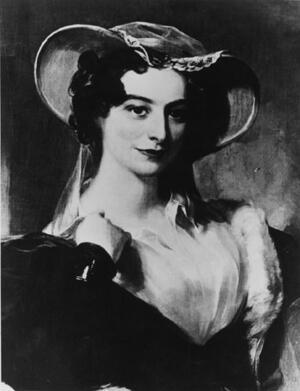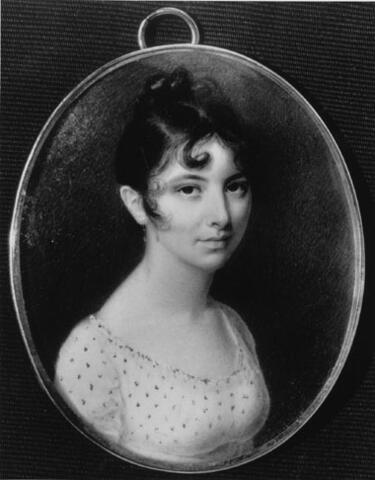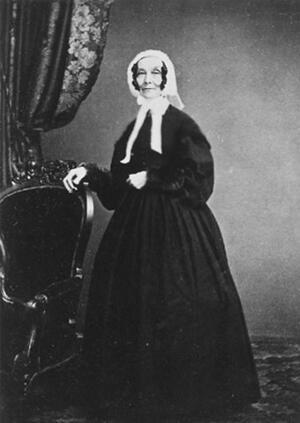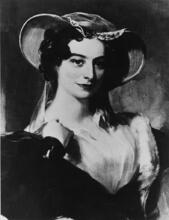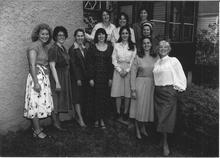Rebecca Gratz
Rebecca Gratz grew up in the wealthy society of Philadelphia and was significantly influenced by the highly political atmosphere of post-revolutionary America. She helped found several philanthropic organizations, including the Philadelphia Orphan Society, a non-sectarian group that sheltered and educated orphans. Over time, however, the evangelical efforts of many Christians involved in charity work convinced Gratz that Jewish children needed a religious education to maintain their cultural identity. The first to apply the Sunday school format to Jewish education, she created lesson plans and materials, taught classes, and raised funds for schools that would teach both boys and girls, in English, about Jewish religion, history, and culture. Her model for Jewish education quickly spread to other cities, becoming the standard for the modern Jewish Sunday school.
Rebecca Gratz believed that with an “unsubdued spirit” she could overcome all of life’s difficulties. A pioneer Jewish charitable worker and religious educator, Gratz established and led America’s first independent Jewish women’s charitable society, the first Jewish Sunday school, the Philadelphia Orphan Asylum, and the first Jewish Foster Home in Philadelphia. She surmounted the grief caused her by the deaths of many family members and loved ones, confronted Christian evangelism, and became a civic leader. Gratz’s accomplishments grew out of her own indomitable spirit and her commitments to both Judaism and America.
Early Life and Education
Born in Philadelphia, Pennsylvania, on March 4, 1781, a middle child among twelve children born to Michael Gratz of Silesia and Miriam Simon of Lancaster, Pennsylvania, Gratz grew up in Philadelphia’s wealthy society. Her father, her uncle Barnard Gratz, and her grandfather Joseph Simon engaged in trading with Indians, land speculation, and coastal shipping. Her brothers Simon, Hyman, Joseph, Jacob, and Benjamin expanded the family financial interest in the American West. Accustomed from youth to the highly charged political atmosphere of postrevolutionary Philadelphia, Gratz became and remained a fervent patriot throughout her life.
In her youth, Gratz attended assembly balls and was part of a circle of writers, including Washington Irving and James Kirk Paulding, who contributed to the Port Folio literary magazine, although she herself never published. After abandoning her early poetry, Gratz confined her literary talent to an extensive correspondence. Her correspondents included British educator and novelist Maria Edgeworth, American author Catherine Sedgwick, renowned British actor Fanny Kemble, Jewish British theologian and educator Grace Aguilar, and other less notable friends and family. The children of Alexander Hamilton, publisher John Fenno, and Rev. John Ewing, president of the University of Pennsylvania, were among her closest friends. Gratz was so well known in elite Philadelphia circles that Irving asked Gratz to introduce Thomas Sully to Philadelphia patrons when the artist moved there. The collected Gratz family portraits include many by Sully as well as by Edward Malbone and Gilbert Stuart. In addition to prominent synagogue responsibilities and Gratz’s own organizations, the Gratz siblings together promoted the city’s Athenaeum, Deaf and Dumb Home, the Academy of Fine Arts, and various libraries.
Well-educated for her day, Gratz attended women’s academies and read her father’s extensive library stocked with literature, histories, and popular science. To that collection Gratz herself added Judaica, seeking original new works in English, works recently translated into English, as well as requesting new books and early readings of works-in-progress from knowledgeable American Jews like hazan Isaac Leeser and educator Jacob Mordecai.
Philanthropic Beginnings
At age nineteen, Gratz was recruited as a family nurse to help her mother care for her father, who had suffered a stroke. Although Gratz at first found nursing “agonizing,” she remained the family nurse throughout her life, sharing duties with her unmarried older sister Sarah, who herself died in 1817. While nursing her father, Gratz joined her mother, sister, and twenty other women, Jewish and gentile, to found Philadelphia’s nonsectarian Female Association for the Relief of Women and Children in Reduced Circumstances (c. 1801). Gratz was its first secretary and held that office for many years. In 1815, Gratz helped establish the Philadelphia Orphan Asylum, and served as secretary for its first forty years. In the 1830s, Gratz advised her sister-in-law Maria Gist Gratz on creating and running the first orphan asylum in Lexington, Kentucky.
Gratz sought the post of executive secretary in each of the institutions she founded. As secretary, she not only maintained organizational records, but also annually addressed the managing boards on policy in each year-end secretary’s report. The institutions regularly published her reports as pamphlets or in the popular press in order to raise public support for their work. The secretary’s role enhanced Gratz’s authority and provided her a public forum from which to advance her own ideas about the ways in which organizations could promote both women’s roles and Judaism in Philadelphia and in America. The Jewish institutions with which she was involved especially reflected her own strong leadership.
Noting that Christian charitable women evangelized while aiding the poor, Gratz became convinced that Philadelphia’s Jewish women and children needed their own charitable institution. In 1819, she gathered women of her congregation to found the country’s first nonsynagogal Jewish charity, the Female Hebrew Benevolent Society (FHBS). The FHBS provided food, fuel, shelter, and later an employment bureau and traveler’s aid service. The FHBS served only Jewish women and their children, and later coordinated its efforts with those of sewing and fuel societies serving needy local Jews. Gratz offered significant advice and aid to these societies as well. The FHBS remained an independent society until the late twentieth century.
Jewish and American Beliefs
Gratz’s religious beliefs reflected her membership in Ritual bathMikveh Israel as well as her own readings and lively discussions with Christian friends. Although Gratz, like most Jewish women and some men, knew no Hebrew, her congregation’s early use of prayer books imported from England, with English translations on facing pages, allowed her a satisfying and devoted synagogue experience throughout her life. Gratz also found religious insight in Shakespeare’s dramas and sonnets and gleaned moral guidance from writers like Thomas Carlyle. She insisted that her Christian friends respect her own understandings of biblical texts and frequently argued Judaism’s truth. She also insisted on Jews’ right to be treated as equals, both as citizens and as pious individuals, under the United States Constitution. These lifelong religious discussions shaped her religious ideas and deepened her convictions. While Gratz believed that American religious freedom presaged a new epoch in Jewish history, she also believed that if Jews were to be respected by the Christian majority they must become religiously knowledgeable and observant. Consequently, she was appalled by Judaism’s nascent Reform Movement, which renounced Zion and diminished ritual. Around 1818, after her sister Sarah’s death, Gratz organized an informal Hebrew school in her home for the children of her extended family, instructed by a young rabbi.
An outspoken woman who found few men likely to be an “agreeable domestic companion” for herself, Gratz remained unmarried. She lived with her three bachelor brothers, Hyman, Joseph, and Jacob, and her sister Sarah throughout her life. Despite her skepticism about marriage, Gratz adored children. When Gratz’s sister Rachel died in 1823, leaving six children, Gratz brought the children to her home and raised them. Their father soon purchased the home directly across the street from Gratz.
Hebrew Sunday School
Gratz was the first to apply the Sunday school format to Jewish education. The FHBS women hoped to provide religious education soon after the organization’s founding, but they were unable to do so until 1838, when Gratz established the Hebrew Sunday School (HSS), a coeducational institution, with herself as superintendent. She also served as secretary of the managing society and held both offices until she was in her eighties. Her sister congregants, Simha Peixotto and Rachel Peixotto Pyke, who ran a private school in their home, joined her as teachers, and the Peixotto sisters wrote many of the textbooks initially used by the school. Students ranged in age from early childhood to early teens. The HSS soon attracted students and faculty throughout Philadelphia, and it remained an independent, citywide institution until the close of the twentieth century.
The HSS offered Jewish women their first public role in teaching religion and determining curriculum in a Jewish school. Only female graduates were invited to join the faculty, and the HSS’s teacher training program furthered the women’s religious education. Gratz advised Jewish women in Charleston, Savannah, and Baltimore on establishing similar schools there. Their efforts prompted the country’s leading Jewish educators, especially Isaac Leeser, who wrote and translated Jewish catechisms for the school, to provide materials for their use. Leeser publicized the HSS and encouraged Jewish women around the country to take similar action.
By the 1840s, Gratz happily noted that Jewish women were “becoming quite literary.” She touted books by British educator Grace Aguilar, who extolled Judaism and argued its importance to women, and used Aguilar’s books in the HSS. Gratz hoped the school would demonstrate that Jewish women equaled Christian women in religious piety, then considered a mark of civility. The school flourished, opened several branches, and had served over four thousand students by the end of the nineteenth century.
Jewish Foster Home and Legacy
By the 1850s, the plight of an increasing number of Jewish immigrants convinced Gratz of the need for the Jewish Foster Home (JFH). Jewish orphan associations in New York and New Orleans, which relied on foster families, became inadequate as immigration increased. Gratz, who had served forty years on the board of the Philadelphia Orphan Asylum, became vice president of the JFH managing society. The JFH later merged with several other institutions to form Philadelphia’s Association for Jewish Children.
Gratz outlived all but her youngest sibling, Benjamin, and many of her nieces and nephews. Despite her grief in her last years, she was relieved that what she believed to be the American experiment in freedom had not ended with the Civil War. She was sure that her lasting monument would be the Hebrew Sunday School, a highly successful institution that most reflected her own unique blend of Judaism and American culture. Gratz died on August 27, 1869, and was buried in Mikveh Israel’s historic cemetery in Philadelphia. By the end of her life, a legend claimed Gratz as the prototype for the character of Rebecca of York in Sir Walter Scott’s novel Ivanhoe, the first favorable depiction of a Jew in English fiction. Jews pointed to Gratz, an Americanized Jewish woman who retained her Jewish loyalty, to argue the truth of the popular tale. Gratz’s own life epitomized the “unsubdued spirit” she admired.
Ashton, Dianne. Rebecca Gratz: Women’s Judaism in Antebellum America (1997), and “Souls Have No Sex: Philadelphia Jewish Women and the American Challenge.” In When Philadelphia Was the Capital of Jewish America, edited by Murray Friedman (1993).
BDEAJ.
Beerman, Leonard I. “An Analysis of the Foremost Jewess of the Nineteenth Century as Reflected in Hitherto Unpublished Source Materials.” Ord. thesis, Hebrew Union College (1949).
Bodek, Evelyn. “Making Do: Jewish Women and Philanthropy.” In Jewish Life in Philadelphia, 1830–1940, edited by Murray Friedman (1983).
Braude, Ann. “The Jewish Woman’s Encounter with American Culture.” In Women and Religion in America, Vol. 1 (1981).
Byars, William V., ed. B. and M. Gratz, Merchants in Philadelphia, 1754–1798 (1916).
Cohen, Mary M. An Old Philadelphia Cemetery: The Resting Place of Rebecca Gratz (1920).
Cohen, Miriam Moses. Papers. Southern History Collection, University of North Carolina, Chapel Hill, North Carolina; Crockett, W.S. The Scott Originals (1912).
DAB.
EJ, s.v. “Gratz.”
Gratz, Rebecca. Papers. American Jewish Historical Society, Brandeis University, Waltham, Mass.
Gratz Family Papers. Collection 72. American Philosophical Society, Philadelphia, Pa.
Gratz Family Papers. Manuscript Collection 236. Henry Joseph Collection, American Jewish Archives, Hebrew Union College, Cincinnati, Ohio.
Jacobs, Joseph. “The Original of Scott’s Rebecca.” Publications of the American Jewish Historical Society 22 (1914): 53–60.
JE, s.v. “Gratz.”
Mordecai, Sarah. Recollections of My Aunt (1893).
NAW.
Osterweiss, Rollin G. Rebecca Gratz: A Study in Charm (1935).
PAJHS 11:89–90, 29:53–60; 31:241; 48:71–77.
Philipson, David, ed. The Letters of Rebecca Gratz (1929).
Rosenbloom, Joseph, “And She Had Compassion: The Life and Times of Rebecca Gratz.” Ph.D. diss., Hebrew Union College (1957), and “Rebecca Gratz and the Jewish Sunday School Movement in Philadelphia.” Publications of the American Jewish Historical Society 47, no. 2 (1958): 71–75, and “Some Conclusions About Rebecca Gratz.” In Essays in American Jewish History (1958).
UJE, s.v. “Gratz.”
Van Renssalaer, Gratz. “The Original of Rebecca in Ivanhoe.” Century Magazine (September 1882).

